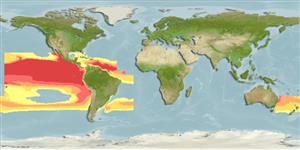>
Aulopiformes (Grinners) >
Scopelarchidae (Pearleyes)
Etymology: Scopelarchoides: Greek, skopelos = a lantern fish + Greek, archos = anus + Greek, oides = similar (Ref. 45335).
Environment: milieu / climate zone / depth range / distribution range
Ekologi
laut batipelagis; kisaran kedalaman 1 - 3294 m (Ref. 26340). Deep-water; 27°N -
Western Central Atlantic: Cuba (Ref. 26340). Eastern Pacific: Baja California, Mexico (about 27°N) to equatorial waters off Panama and Colombia (5°-9°N), and off Peru (about 6°-12°S) (Ref. 35929); also Chile (Ref. 9068).
Size / Weight / umur
Maturity: Lm ? range ? - ? cm
Max length : 10.5 cm SL jantan/; (Ref. 130965)
Duri punggung (Keseluruhan (total)) : 0; duri punggung lunak (Keseluruhan (total)) : 6 - 7; Duri dubur: 0; Sirip dubur lunak: 20 - 23; vertebrata, bertulang belakang: 45 - 48. Branchiostegal rays: 8.
Occur in shallower part of depth range at night, deeper during the day (Ref. 35929). Oviparous, with planktonic larvae (Ref. 35929). Synchronous hermaphrodites (Ref. 35929).
Claro, R., 1994. Características generales de la ictiofauna. p. 55-70. In R. Claro (ed.) Ecología de los peces marinos de Cuba. Instituto de Oceanología Academia de Ciencias de Cuba and Centro de Investigaciones de Quintana Roo. (Ref. 26340)
Status IUCN Red List (Ref. 130435)
ancaman kepada manusia
Harmless
penggunaan manusia
Alat, peralatan
laporan khas
muat turun XML
Sumber internet
Estimates based on models
Preferred temperature (Ref.
123201): 3.5 - 9.5, mean 5.2 °C (based on 238 cells).
Phylogenetic diversity index (Ref.
82804): PD
50 = 0.5313 [Uniqueness, from 0.5 = low to 2.0 = high].
Bayesian length-weight: a=0.01122 (0.00514 - 0.02450), b=3.04 (2.87 - 3.21), in cm total length, based on all LWR estimates for this body shape (Ref.
93245).
Trophic level (Ref.
69278): 4.1 ±0.7 se; based on size and trophs of closest relatives
Fishing Vulnerability (Ref.
59153): Low vulnerability (10 of 100).
